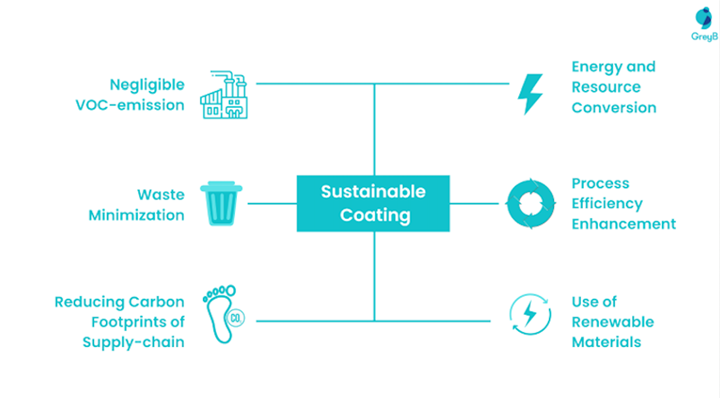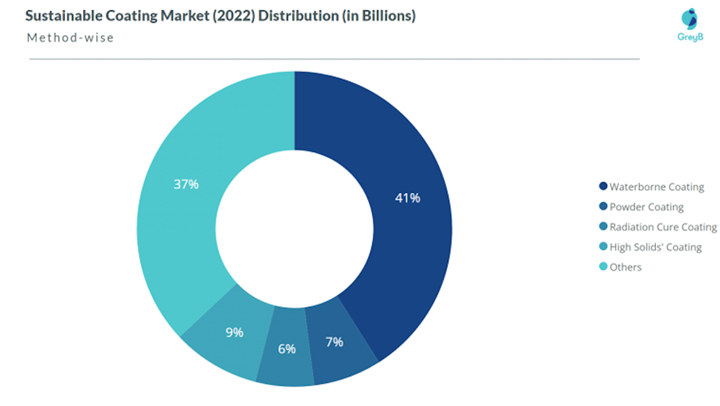
The industrial coatings industry prides itself on being one of the most innovative and dynamic manufacturing industries. Industrial coatings have evolved hugely over the past few decades, resulting in exciting applications across the global economy. This includes everything from the aviation and automotive industries, to industrial applications and residential housing.
It’s also an industry experiencing enormous growth. The industrial coatings market has been projected to grow from $102 billion in 2021 to $116 billion by 2026, which equates to a compound annual growth rate (CAGR) of 2.5%, according to MarketsAndMarkets.
With growth comes more potential competition and, in turn, an even greater need to be innovative and stand out. Unsurprisingly, technology has a significant role, which is why this article will focus on the benefits of new technologies in the industrial coatings market.
The benefit of ‘green’ coatings
Ecologically sound industrial coatings are leading the way in innovation. The driver for this is quite simple: there has been an exponential increase in demand for environmentally-friendly coatings.
The regulatory framework has also changed in many countries. A good example is the slew of regulations passed globally, regarding volatile organic compounds or VOCs. The European Union has regulations regarding VOC emissions in coating resins that date back to 2007. In 2021, the federal government in Canada sought to renew its control of VOC emissions. These regulations have undoubtedly impacted the production of all coatings that may emit VOCs, including innovation and research and development (R&D).
Chemicals are an ongoing headache for the industry, with mounting pressure from several regulatory agencies. For example, in the United States, the allowable concentrations of Xylol and other solvents for potable water storage tank linings will be covered by a new, stringent standard issued by the National Science Foundation (NSF), which comes into effect in 2023. The European Union’s REACH regulation (which stands for Registration, Evaluation, Authorisation and Restriction of Chemicals) remains a far-reaching benchmark for European coating producers. Its stringent requirements for various chemicals mean that coatings manufacturers have had to be diligent about the chemicals used in their products.
Green or sustainable coatings are not only concerned about VOCs and other chemical pollutants, but a host of other factors, as can be seen in the graphic below:

Today, sustainable industrial coatings have evolved diversely, including improved ecological efficiencies in the coatings production process. An example of this is evident in the architectural coatings sector, and, specifically, in powder coatings. The sustainability credentials of these coatings are undeniable: they ensure high utilization of material (as high as 99%), with overspray easily recycled. Furthermore, newly developed powder coatings require fewer layers of coating to achieve the same result, particularly when compared to liquid coatings.
Even so, it is the waterborne coatings that continue to significantly lead the way in the sustainable coating market as of 2022 — as seen in the graphic below:

Self-cleaning coatings
The technology in ‘self-cleaning’ industrial coatings has come to the forefront in recent years, with multiple benefits for industrial processes. For example, the global market in hydrophobic coatings — the coatings made to deflect or repel liquids — was estimated at $1.8 billion in 2021. This niche coatings industry is expected to grow to more than $3 billion by 2030, at a CAGR of over 5.5%, with much of the demand coming from the medical equipment and device industry.
Self-cleaning coatings have a wide range of applications, with more typical examples being those for paints, window glasses, cement, and textiles. Hydrophobic coatings, such as certain paints, can cause what is known as the ‘lotus effect’. The lotus effect gets its name because of how these coatings repel water in small puddles, similar to what can be seen on the surface of a lotus leaf — which is itself hydrophobic. Hydrophilic self-cleaning coatings work on the basis of photocatalysis: they break down impurities such as dirt when exposed to sunlight, and are then washed away when water is applied.
An example of the exciting possibilities with self-cleaning coatings was explored in a 2021 Chinese study, which found that a durable waterborne coating with superhydrophobic function had excellent outcomes for a range of different applications. These included finishes for construction, electronic instruments, leather finishes, vehicles, wooden furniture, and even the preservation of historical sites.
AI and industrial coatings
Artificial intelligence (AI) and other emerging, smart technologies are transforming the industrial coatings industry in exciting ways. These include:
-
Algorithmic optimization of production schedules and product mixing
-
Finishing lines that are self-scheduling
-
Digital twin (DT) technology can be used to duplicate physical prototypes, allowing for more exacting real-time detection of design flaws, and other R&D capabilities
-
Titrations, other analyses, and material additions can be completed automatically and in real-time using sensors and other smart devices, rendering time-consuming and production-slowing lab sampling obsolete.
Furthermore, AI means that quality defects are driven to zero. How? By using in-process inspection with computer vision, and other smart systems that identify quality defects in-process. The result — no more need for final inspections.
Beyond inspections and quality control, AI has been fully embraced by the once-conservative maintenance industry. Maintenance departments are harnessing the full potential of the Industrial Internet of Things (IIoT), which means that data-driven maintenance systems can detect better, and even react instantly to emerging faults. The results include fewer asset breakdowns, improved asset lifespans, fewer shutdowns, and — consequently — significant cost savings. The coatings industry can derive the same types of benefits within its own maintenance processes, thereby enabling smarter, more cost-efficient production.
Big Data: transforming the coatings industry
A further extension of AI is Big Data, an enormous niche issue with ever-growing importance for the coatings industry. Importantly, it is data that contains huge variety, in ever-increasing volume and it’s gathered at a great velocity. That is what is referred to as the ‘3 Vs’ of big data.
Erik Sapper, an assistant professor in the Western Coatings Technology Center at California Polytechnic State University in San Luis Obispo, believes that the coatings industry needs to ask itself three questions regarding data:
-
What data do we have?
-
What data do we need?
-
What questions are we trying to answer?
Sapper’s point is that the industry is awash in data, but so much lies stagnant in endless reports and published literature, not to mention the subject matter expertise of industry experts. The good news is that AI and its brilliant offspring, machine learning (ML), can do much to make sense of all this data.
Helpful data in the industry can include small molecule structure-property data, polymer synthesis procedures and outcomes, formulation recipes, formulation design space data, as well as the service life data of products. Much of this data is quantitative, which is just the type of data that AI and ML love to probe and analyze.
Nanotechnology and the coatings industry
Nanotechnology is one of the most exciting new technologies that is already transforming the coatings industry. The European Commission (EC) refers to nanotechnology as,
“...the term given to those areas of science and engineering where phenomena that take place at dimensions in the nanometre scale are utilized in the design, characterization, production and application of materials, structures, devices, and systems”.
To provide perspective on just how small a nanometre (nm) really is, consider that a strand of human hair is around 80,000 to 100,000 nanometres wide.
‘Nano paints’ based on nanotechnology already exist in the market. Tiny fragments of metals or ceramics, for example, can be inserted into paints and coatings. This type of nano-integration into the paint matrix can be in the form of particles, free powder, or granulates. The result is a paint or coating with specific properties for specialized application.
A surface that requires electrically-conductive coating is one such example, with UV protection being another. These innovative paints can also be highly resistant to corrosion, scratching, and wear.
Ever-tinier nanoparticles serving as raw material additions can give coating and paint unique properties — including tougher adhesion — that cannot be attained with simple barrier chemistries. Corrosion resistance and self-cleaning characteristics that don’t damage the existing characteristics of coatings are also being explored.
It is estimated that tens of thousands of nanotechnology patents have been issued in the past decade alone. These are exciting times for the coatings industry. Not only is the coatings market growing at a good pace, but the benefits of embracing new technologies are abundantly clear.
To not be smart with technology could be precarious, even detrimental, for a coatings manufacturer. As the American writer Stewart Brand said: “Once a new technology rolls over you, if you're not part of the steamroller, you're part of the road.” Stark words, but in this age of fast-evolving technology, anyone in the coatings industry would be foolish not to heed.
About the Author

Bryan Christiansen
Bryan Christiansen is the founder and CEO of Limble CMMS. Limble is a modern, easy-to-use mobile CMMS software that takes the stress and chaos out of maintenance by helping managers organize, automate, and streamline their maintenance operations.
Related Content
Henry Ford Is Still Right When It Comes to Color
Who would have imagined that more than 100 years after his famous statement about any color as long as it’s black would still have relevance of a sort?
Read MoreFinishing Systems Provider Celebrates 150 Years, Looks to Future
From humble beginnings as an Indiana-based tin shop, Koch Finishing Systems has evolved into one of the most trusted finishing equipment providers in the industry.
Read MoreShedding Light on Surface Inspection
State-of-the-art reflector-based lighting system improves luminosity and ergonomics for surface inspection tasks while reducing energy usage.
Read MoreMasking Solutions Provider CFS Dramatically Expands Capabilities and Capacity
Custom Fabrication & Supplies (CFS) completed a new plant expansion packing 10 times the capacity into twice the space. It dramatically enhances the supplier’s custom capabilities to provide extremely precise and cost-effective masking solutions.
Read MoreRead Next
A ‘Clean’ Agenda Offers Unique Presentations in Chicago
The 2024 Parts Cleaning Conference, co-located with the International Manufacturing Technology Show, includes presentations by several speakers who are new to the conference and topics that have not been covered in past editions of this event.
Read MoreEpisode 45: An Interview with Chandler Mancuso, MacDermid Envio Solutions
Chandler Mancuso, technical director with MacDermid Envio discusses updating your wastewater treatment system and implementing materials recycling solutions to increase efficiencies, control costs and reduce environmental impact.
Read MoreDelivering Increased Benefits to Greenhouse Films
Baystar's Borstar technology is helping customers deliver better, more reliable production methods to greenhouse agriculture.
Read More











.jpg;maxWidth=300;quality=90)










